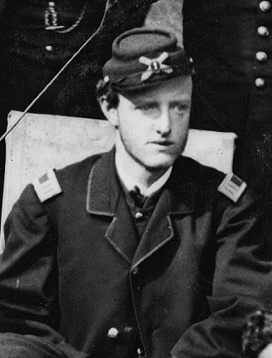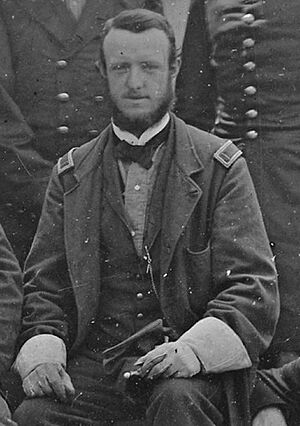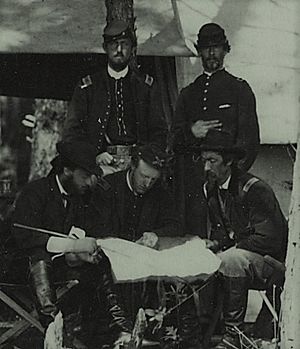Alanson Merwin Randol facts for kids
Quick facts for kids
Alanson Merwin Randol
|
|
|---|---|
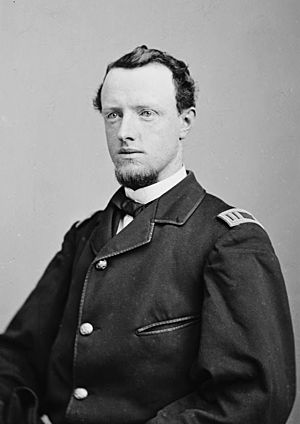 |
|
| Born | October 23, 1837 Newburgh, New York, US |
| Died | May 7, 1887 (aged 49) New Almaden, California, US |
| Place of burial |
San Francisco National Cemetery, San Francisco, California, US
|
| Allegiance | |
| Service/ |
|
| Years of service | 1860–1887 |
| Rank | |
| Unit | 1st Missouri Light Artillery 1st U.S. Artillery 3rd U.S. Artillery 4th U.S. Artillery 2nd New York Cavalry Regiment |
| Commands held | Battery L, 1st Missouri Light Artillery Battery E & G, 1st U.S. Artillery Battery I, 1st U.S. Artillery Battery H, 1st U.S. Artillery 2nd New York Cavalry Regiment Battery K, 1st U.S. Artillery Battery L, 1st U.S. Artillery Fort Delaware Fort Winfield Scott Fort Alcatraz Fort Canby |
| Battles/wars | American Civil War
|
| Alma mater | United States Military Academy |
| Spouse(s) | Elizabeth Beck Guion (m. 1869) |
| Children |
|
| Signature | |
Alanson Merwin Randol (born October 23, 1837 – died May 7, 1887) was an American soldier. He was an artillery officer in the United States Army. He also graduated from the United States Military Academy at West Point in 1860.
Randol served bravely in the American Civil War. He was promoted many times for his courage in battle. He rose from a second lieutenant to a brevet brigadier general of volunteers.
He was known as a skilled artillery officer. He fought with the 1st U.S. Artillery in almost every major battle in the eastern part of the Civil War. Later, he commanded the 2nd New York Cavalry Regiment from December 1864 to April 1865. He was even there to see General Robert E. Lee surrender at Appomattox Court House.
After the Civil War, Randol returned to the regular army. He commanded artillery companies across the United States. He served from 1865 until he died in 1887.
Contents
Early Life and Military Training
Alanson Merwin Randol was born in Newburgh, New York. He was one of seven children. His father worked at the United States Mint in New York.
In 1850, Randol lived in Redding, Connecticut. He went to a private boarding school there. In 1855, when he was 17, he got into the United States Military Academy at West Point, New York.
Randol did very well at West Point. He was usually in the top 15 of his class. He graduated 9th in his class in June 1860.
After West Point, Randol became a second lieutenant. He was sent to the United States Army Ordnance Corps in California. This department handles weapons and ammunition.
Civil War Service
Joining the Fight
After the Battle of Fort Sumter in April 1861, Lieutenant Randol was sent east. He was ordered to join the fighting in the Eastern Theater of the American Civil War. In May 1861, he was promoted to first lieutenant.
He first served with Major General John C. Frémont's forces. He commanded Battery L, 1st Missouri Light Artillery Regiment.
Later, Randol joined the artillery defenses of Washington, D.C.. In January 1862, he took command of Battery E, 1st U.S. Artillery. His battery was given six powerful 12-pounder "Napoleon" guns.
His unit was later combined with part of Battery G, 1st U.S. Artillery. This new unit was called Battery E & G, 1st U.S. Artillery. People often called it "Randol's Battery."
Peninsula Campaign and Seven Days Battles
In March 1862, Randol's Battery E & G joined Major General George B. McClellan's army. They were part of the Peninsula campaign in Virginia. They helped in the Siege of Yorktown.
The battery then moved with the army toward the Chickahominy River. After some tough battles, the Union army began to retreat. This retreat led to the Seven Days Battles.
Battle of Glendale
On June 29, 1862, Randol's battery was sent to support another division. This division had lost many soldiers in earlier fights. Their job was to defend a key road junction at Glendale. The entire Union army needed to pass through this area safely.
The division got lost in the dark. Randol's battery ended up too far west. They soon realized Confederate soldiers were very close by.
Randol's battery was placed on the right side of the Union line. They faced a wide-open field. Confederate forces attacked in waves. Randol bravely moved his cannons to fire at the attacking enemy.
Suddenly, two Confederate regiments attacked Randol's right side. He quickly turned his cannons to face them. His men fired powerful "canister shot" (like a giant shotgun blast). They pushed back two enemy attacks.
However, some Union infantry charged forward, blocking Randol's cannons. This allowed the Confederates to rush the battery. They fought hand-to-hand. Randol's men were forced to leave their guns.
Randol, with the help of other officers, rallied some infantry. They fought back and briefly retook the cannons. But many horses were killed, and they couldn't move the heavy guns. As darkness fell, they had to leave all six of their 12-pounder cannons behind.
Randol's battery lost two men killed and nine wounded. All six of their cannons were lost. These captured cannons were later used by the Confederates. It's possible Randol was even fired upon by his own former guns!
After Glendale and Second Bull Run
After the battle, Randol's remaining men joined another battery. Randol himself helped other officers during the Battle of Malvern Hill. For his bravery at Glendale, Randol was promoted to captain.
His battery was re-equipped with new cannons. They then joined Major General Joseph Hooker's division.
In August 1862, Randol's battery fought in the Second Battle of Bull Run. They were under constant fire. The battle was a Union defeat. Years later, Randol testified in a case to help clear the name of a general blamed for the loss.
Maryland Campaign to Fredericksburg
After Second Bull Run, Randol's battery went to Maryland. They were held in reserve during the Battle of South Mountain. At the Battle of Antietam on September 17, they helped push back Confederate artillery.
In October 1862, Randol was promoted to captain of another battery. But he stayed in command of Battery E & G.
In November, his unit moved with the army toward Fredericksburg, Virginia. Randol became the chief artillery officer for his division. At the Battle of Fredericksburg in December, his battery was near Marye's Heights. This battle was a big Confederate victory.
Mud March and Chancellorsville
In January 1863, Randol's battery joined the "Mud March." This was a difficult movement by the army in bad weather. They then went into winter camp.
In May 1863, they moved to Chancellorsville, Virginia. They supported Union forces during the Battle of Chancellorsville. His battery mostly stayed in reserve during this battle.
Horse Artillery and Gettysburg Campaign
In May 1863, Randol's battery joined the Horse Artillery. This meant their cannons could move very quickly with cavalry. Their 12-pounder cannons were replaced with lighter, faster 3-inch Ordnance Rifles.
They trained as "flying artillery." Then, they joined the Cavalry Corps. They fought in several battles, including Aldie and Upperville.
Randol's battery arrived at Gettysburg on July 2, 1863. On July 3, while the main fight was at Cemetery Ridge, Randol's battery fought against Confederate cavalry. They successfully stopped the enemy from flanking the Union army.
For his brave actions at Gettysburg, Randol was promoted to major. After the battle, his battery chased the retreating Confederate army.
Later Campaigns and West Point
In September 1863, Randol took command of Battery H, 1st U.S. Artillery. He also commanded an artillery brigade. He led Battery I in the Mine Run Campaign during the winter of 1863-64.
In April 1864, Battery I was combined with Battery H. This new unit was called Battery H & I, 1st U.S. Artillery. In May, they joined Ulysses S. Grant's Overland Campaign. They were part of major battles like the Battle of the Wilderness and Spotsylvania Court House.
In August 1864, Randol was temporarily assigned to West Point. He taught mathematics and artillery tactics. He wanted to command a New York volunteer regiment.
Commanding the 2nd New York Cavalry
In December 1864, Randol became a colonel. He took command of the 2nd New York Cavalry Regiment. In March 1865, his unit joined the Appomattox campaign. They were part of Brevet Major General George Armstrong Custer's division.
At the Battle of Appomattox Station, Randol's cavalry unit helped capture important Confederate supplies. Custer encouraged Randol to fight hard. Randol's regiment was about to charge a Confederate position when the enemy surrendered.
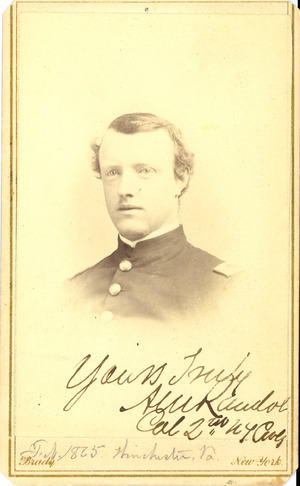
Randol was promoted to brevet lieutenant colonel and brevet colonel for his brave service. He was present at Appomattox Court House on April 9, 1865. This is where Robert E. Lee surrendered to Ulysses S. Grant. Randol even met famous Civil War photographer Mathew Brady there.
Post-Civil War Career
After the Civil War, Randol returned to his rank of captain. He commanded Battery I, 1st U.S. Artillery. In 1866, he was promoted to brevet brigadier general of volunteers for his war service.
The U.S. Army sent its units to different posts across the country. Captain Randol served in many places:
- Fort Brown in Brownsville, Texas (1865-1869)
- Fort Trumbull, Connecticut (1869-1870)
- Fort Delaware, Delaware (1870)
- Fort Wood, New York (1870-1872)
- Fort Hamilton, New York (1872)
- The Citadel in Charleston, South Carolina (1872-1873)
- Fort Barrancas, Florida (1873-1875)
- Fort Independence, Massachusetts (1875-1879)
- Fort Warren, Massachusetts (1879-1881)
He also commanded Battery K and Battery L of the 1st U.S. Artillery.
During the elections of 1874 and 1876, his battery was sent to Southern states. Their job was to help keep order.
In July 1877, Randol's battery was sent to Pittsburgh, Pennsylvania. This was during the Great Railroad Strike of 1877. Their train was attacked by rioters near Johnstown, Pennsylvania. The soldiers had to protect themselves until more help arrived.
In 1881, Randol's regiment moved to the West Coast. They were stationed at the Presidio in San Francisco, California. Randol was promoted to major in the 3rd U.S. Artillery in 1882.
He returned to the 1st U.S. Artillery. He commanded Fort Winfield Scott and Fort Alcatraz in San Francisco Bay. His last command was Fort Canby in Washington Territory.
Randol wrote essays about his experiences in the Civil War. He described commanding his artillery batteries and the 2nd New York Cavalry.
Illness and Death
In 1886, Randol's health got worse. He was diagnosed with kidney disease. This might have been from being exposed to yellow fever during his service.
He left Fort Canby for a warmer climate in San Francisco. He died on May 7, 1887, in New Almaden, California.
Personal Life
Alanson Randol married Elizabeth Beck Guion in 1869. She was the daughter of an Army chaplain.
When he died, Randol had four children. One of his sons, Marshall Guion Randol, later became a brigadier general. Five of his other children died when they were very young.
Randol died at the home of his brother, James Butterworth Randol. His brother managed a quicksilver mine in New Almaden.
Legacy
A coastal artillery battery at Fort Worden was named after Randol in 1904.
See Also
- List of American Civil War brevet generals (Union)
- Battery E, 1st U.S. Artillery
- Battery G, 1st U.S. Artillery
- Battery I, 1st U.S. Artillery
- Battery K, 1st U.S. Artillery
Images for kids


